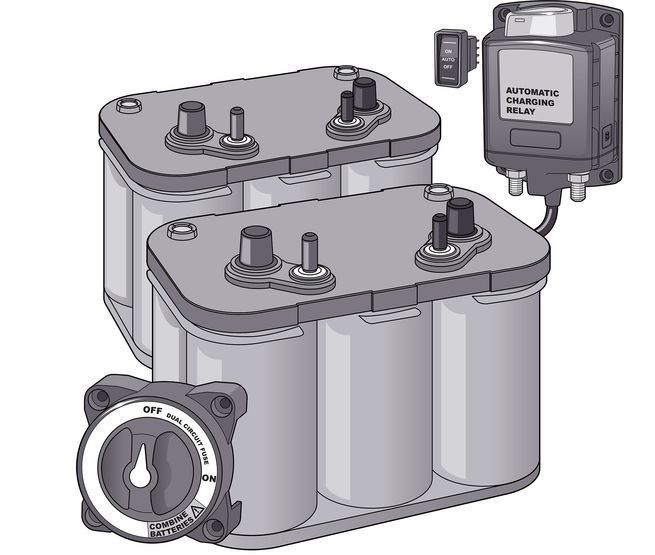
Dual batteries offer redundant starting capability.
However not all batteries are the same.
Here's a great article by Kevin Falvey written and published in the October 5, 2017 IN BOATING
A multiple-battery system’s best attribute may be the ability to provide engine starting should one battery short out, experience a wiring failure or simply get drained. The capability to run electronics, lights and stereos for longer periods also proves beneficial.
Consider these multi battery features whether shopping for a new boat or retrofitting your current boat.
Battery Type
The charging characteristics vary between battery types: absorbed glass mat (AGM), flooded cell and gel cell. Integration with engines, chargers and other components is easier if all batteries are the same type.
Battery Class
For most boaters, a pair of dual-purpose batteries serves as a good foundation. A starting battery and a deep-cycle battery, or bank of batteries, might serve a bass fisherman, or other boater with high accessory demands, better.
Battery Capacity
Ensure sufficient starting amperage by checking your engine’s owner’s manual for the appropriate capacity. Selecting the deep-cycle battery’s — or bank’s — size is more involved. Basically, you need to add up your anticipated amperage draw and assume a period of time you’ll need that amperage to flow.
Manual Switching
Manual switches are reliable but require you to remember to manually switch between batteries (or banks) in order to keep all batteries charged.
Automatic Switching
Voltage sensitive relays (VSR), and other devices, sense when a battery needs a charge and direct charging current from the alternator automatically. These can be built into the engine or may be a separate component. Such systems may simply have “on/off” switches rather than a four-position manual switch. Make sure a parallel switch to join both batteries for emergency starting is incorporated. (One is often installed at the helm.)
Access
Batteries should be accessible to the extent that they can be serviced and inspected without removal from the boat. Even if you do not perform your own service, good access will save you because it will take the technician less time to perform the task. The closer to the engines the batteries are, the better. Batteries should be robustly secured, be located where there is some ventilation, and not be installed directly underneath a battery charger or fuel-system fixture.
Cables
Cable diameter is directly related to a dual-battery system’s performance. There are formulas you can reference for determining the size of cable based on the amperage it must carry and over what distance. Suffice to say, thicker cables, which exhibit less voltage drop, are generally better, so when comparing the systems in two similar boats, compare the cable diameters.
What’s the difference between battery classifications? This is a thumbnail sketch.
Starting batteries deliver high amperage for quick engine starts but do not tolerate being used to power equipment. Deep-cycle batteries can be drawn down without damage to power equipment but may not provide enough amperage in a burst to start the engine. Dual-purpose batteries offer the ability to provide a lot of amperage in a burst for engine starting, but they do not provide equivalent performance to a deep-cycle battery for running equipment.